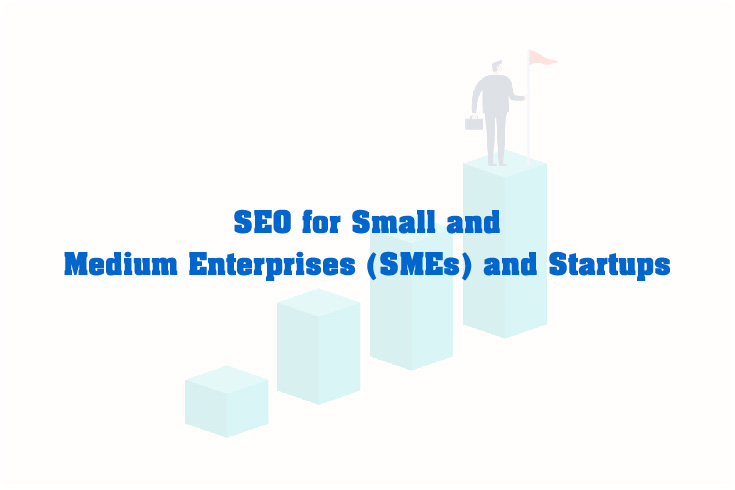SEO for Small and Medium Enterprises (SMEs) and Startups
- Why Do Small and Medium-Sized Enterprises (SMEs) Need SEO?
- Key Elements of SEO for Small Business Websites - From Viet SEO's point of view
- 6-Step SEO Process for SMEs and Startups
- Step 1: Audit Your Current Website (If Any)
- Step 2: Keyword Research
- Step 3: On-page Optimization
- Step 4: Create High-Quality Content
- Step 5: Link Building
- Step 6: Monitor and Improve
- Common SEO Mistakes Made by Small Businesses and Startups
- 1. Chasing Irrelevant High-Volume Keywords
- 2. Keyword Overstuffing
- 3. Lack of a Clear Content Plan
- 4. Neglecting Content Quality
- 5. Ignoring or Mismanaging Backlinks
- 6. Not Optimizing for Mobile Devices
- Local SEO – A Secret Weapon for Small Businesses
- Free SEO Tools for Small Businesses
- Google Search Console:
- Google Analytics:
- Google Keyword Planner:
- Ubersuggest:
- Yoast SEO (for WordPress):
- Conclusion: SEO Is a Long-Term Investment for Small Businesses
SEO website is a set of techniques aimed at improving a website’s ranking on search engine results pages like Google. The goal is to get your website to appear as high as possible when users search for related keywords.
Why Do Small and Medium-Sized Enterprises (SMEs) Need SEO?
In today’s competitive digital landscape, SEO (Search Engine Optimization) has become an essential strategy for small and medium-sized enterprises (SMEs) aiming to build their online presence and grow sustainably. Unlike paid advertising methods such as Google Ads or Facebook Ads, SEO offers a cost-effective way to attract consistent, long-term organic traffic.
Key Benefits of SEO for SMEs:
1. Cost-Effective, Long-Term Results
While paid advertisements can quickly consume a limited budget, SEO generates a steady stream of organic traffic that continues long after the initial setup. Viet SEO agency provides tailored strategies to help SMEs get the most out of their budget and build lasting growth.
2. Enhanced Credibility and Trust
Websites that rank higher on search engine results pages (SERPs) are generally perceived as more trustworthy. With the right SEO guidance, SMEs can strengthen their online reputation, gain customer trust, and encourage repeat visits.
3. Targeted Audience Reach
SEO connects businesses with users who are actively searching for their products or services. By aligning content with user intent, companies can reach their ideal audience at the right time, increasing conversion potential.
4. Compete with Larger Competitors
One of the greatest advantages of SEO is its ability to level the playing field. Even with a limited marketing budget, SMEs can outrank bigger competitors by applying focused, well-executed strategies. With support from Viet SEO, smaller businesses can increase visibility and compete effectively in crowded markets.
By embracing SEO, small and medium-sized enterprises can gain greater online visibility, attract high-quality leads, and create a strong foundation for long-term success—regardless of their marketing budget.
Key Elements of SEO for Small Business Websites - From Viet SEO's point of view
To implement SEO effectively, businesses need to understand three core components. With VietSEO, you can master these elements and achieve higher rankings on search engines.
a. On-page SEO
Optimizing elements directly on your website:
- Keyword Optimization: Research and use keywords that match your audience’s search intent.
- Title and Meta Description: Write compelling titles and descriptions containing target keywords.
- Friendly URL Structure: Keep URLs short, memorable, and keyword-rich.
- Page Load Speed: A slow website hurts both user experience and Google rankings.
- Content Optimization: Provide high-quality, helpful content that addresses users' needs.
- Mobile-Friendly Design: A responsive mobile layout is a must.
b. Off-page SEO
Activities outside your website that enhance credibility and visibility:
- Backlink Building: Getting links from reputable websites improves your domain authority.
- Content Marketing: Share your content on social media, forums, and niche blogs to increase visibility.
- Local SEO: Optimize your Google My Business profile, include address/map info to reach nearby customers.
c. Technical SEO
Technical practices that ensure your website is search-engine friendly:
- Sitemap.xml: Helps Google understand your website’s structure.
- robots.txt: Tells search engines which pages to crawl or ignore.
- SSL – Security Certificate: An HTTPS website builds trust with users.
- Schema Markup: Enables rich search results with extra information.
6-Step SEO Process for SMEs and Startups
Follow these steps to launch a successful SEO campaign. By incorporating best practices from Viet SEO, you can enhance visibility and improve search engine rankings effectively.
Step 1: Audit Your Current Website (If Any)
- Check page load speed.
- Identify basic SEO errors.
- Evaluate existing content.
- Determine keywords currently ranking.
Step 2: Keyword Research
- Use tools like Google Keyword Planner, Ahrefs, SEMrush.
- Focus on long-tail keywords for lower competition and more specific intent.
- Align keywords with each stage of the buyer’s journey: awareness – consideration – decision.
Step 3: On-page Optimization
- Write SEO-friendly content with clear H1, H2, H3 structure.
- Optimize images (file names, ALT tags).
- Prioritize value-driven content over keyword stuffing.
Step 4: Create High-Quality Content
- Build a business blog focused on customer pain points and needs.
- Keep content fresh with regular updates.
- Use diverse formats: lists, guides, case studies, etc.
Step 5: Link Building
- Look for guest post opportunities on reputable blogs.
- Join communities and forums to share content and earn natural backlinks.
- Create strong internal links among your own blog posts.
Step 6: Monitor and Improve
- Use Google Analytics and Search Console to track traffic and keyword performance.
- Regularly check your rankings.
- Update and optimize older content to keep it relevant.
Common SEO Mistakes Made by Small Businesses and Startups
When starting out, small businesses and startups often make SEO mistakes that can hinder progress and limit their ability to achieve better search engine rankings. Below are some of the most common pitfalls to avoid:
1. Chasing Irrelevant High-Volume Keywords
New businesses often focus on high-volume keywords, believing they’ll bring in more traffic. But if those keywords aren’t relevant to your products or services, the traffic won’t convert. It's important to conduct in-depth keyword research and prioritize terms that align with what your target audience is truly looking for.
2. Keyword Overstuffing
Cramming too many keywords into your content can make it feel forced and unnatural. Search engines now favor content that provides genuine value and flows well. By following VietSEO's best practices, you can integrate keywords seamlessly and create content that appeals to both readers and search engines.
3. Lack of a Clear Content Plan
Publishing without a strategy often leads to inconsistency and missed opportunities. A structured content plan helps you define key topics, publishing timelines, and performance tracking. Viet SEO encourages SMEs to plan their content journeys with intention to maintain consistent and engaging output.
4. Neglecting Content Quality
Focusing on quantity instead of quality can hurt your brand image. High-quality, relevant content not only improves rankings but also keeps visitors engaged. Establishing clear content standards ensures every piece of content represents your business well.
5. Ignoring or Mismanaging Backlinks
While backlinks are essential for SEO, relying on low-quality or spammy sources can damage your domain authority. It’s more effective to build genuine relationships and earn links from credible, relevant sites in your industry.
6. Not Optimizing for Mobile Devices
With the majority of users browsing on mobile, having a responsive, mobile-friendly site is critical. Businesses that neglect this often see higher bounce rates and lower search visibility. Mobile optimization improves user experience and search performance across all devices.
By recognizing and avoiding these common missteps—and applying a strategic, user-focused approach—startups and small businesses can build a solid foundation for long-term SEO success.
Local SEO – A Secret Weapon for Small Businesses
Local SEO is one of the most powerful strategies for SMEs and startups with physical locations. With the expertise of Viet SEO company, these businesses can enhance their local search visibility, attract more nearby customers, and strengthen their presence in the community.
Benefits:
- Reach nearby customers more quickly.
- Build trust with your local community.
- Show up in location-based search results like “coffee shop near me” or “bike repair District 3.”
How to Do Local SEO Effectively:
- Create and optimize your Google My Business (GMB) profile: include business name, address, phone number, hours, and photos.
- Encourage happy customers to leave reviews on GMB.
- Add your business address to your website footer.
- Write location-specific content like “SEO solutions for small businesses in Hanoi.”
Free SEO Tools for Small Businesses
Getting started with SEO doesn’t have to mean spending a lot of money. There are a number of free tools available that can help small businesses improve their search engine rankings and gain more visibility online. Here are some of the best options, along with a brief overview of how each one can be used:
-
Google Search Console:
This essential tool from Google lets you monitor your site’s search performance, track keyword rankings, and identify any indexing issues. By regularly reviewing the data in Google Search Console, you can spot opportunities for improvement and address technical problems that may be holding your site back.
-
Google Analytics:
With Google Analytics, you can gain valuable insights into user behavior, such as where your traffic is coming from, which pages are most popular, and how visitors navigate through your site. This data is critical for understanding what’s working and what needs to be refined in your SEO strategy.
-
Google Keyword Planner:
Originally designed for Google Ads, this free tool also works well for SEO research. It helps you discover new keyword ideas, see search volume estimates, and find related terms that can improve your content strategy. By targeting the right keywords, you can make your site more relevant to your audience.
-
Ubersuggest:
Ubersuggest offers a variety of features, including keyword suggestions, content topic ideas, and even backlink data. It’s a great starting point for small businesses that need a simple way to identify opportunities for growth without investing in expensive tools.
-
Yoast SEO (for WordPress):
If you’re using WordPress, Yoast SEO is a must-have plugin. It helps with on-page optimization, such as improving meta descriptions, checking keyword usage, and ensuring your content is well-structured and readable. It’s an easy-to-use solution for making sure your posts and pages are search engine-friendly.
How Viet SEO Can Help:
These free tools can provide a strong foundation for your SEO efforts. However, to truly maximize their potential, it’s beneficial to have expert guidance. Viet SEO specializes in helping small businesses get the most out of these tools, offering insights and strategies that take your SEO campaigns to the next level.
Conclusion: SEO Is a Long-Term Investment for Small Businesses
Investing in SEO for your SME or startup isn’t a one-time job – it’s an ongoing process that requires patience, strategic thinking, and adaptability. But when done right, SEO brings sustainable value, reduces your dependency on ads, and fosters steady business growth in the digital era.
Action Plan Recap:
- Start with analysis and keyword research.
- Create quality content and optimize On-page factors.
- Build backlinks and focus on Local SEO.
- Monitor, improve, and stay consistent.
If you're a small business owner or launching a startup, begin step by step – even small steps count. SEO isn’t magic, but it’s the most reliable long-term path to sustainable success.



